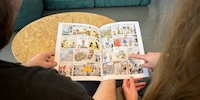

The Last Ronin II – Re-Evolution: a new generation of Turtles emerges
Leaving the past behind, Re-Evolution follows four young Turtles on a journey through self-doubt, bonding and cybernetic scrap.
I still vividly remember opening the first issue of The Last Ronin. Late at night, half asleep, glass of cold milk in hand, I was hit with that first gritty splash page: Michelangelo, drawn like an aged warrior, broken, angry and ready to die. With that, my nostalgia trip turned into a punch in the gut. Seeing the last Turtle alone against the world felt like a swan song to my childhood. But a worthy one. Unfamiliar with the story? Or has it just been too long? Don’t worry, I’ll fill you in on the details later.
The Last Ronin II – Re-Evolution brings the story into its third chapter. But this time, it’s different. Fresher. Younger. Just as tragic, but with a new energy. And yes, I was sceptical.
The complete hardcover edition has been available here in English since 8 July 2025. Kevin Eastman and Tom Waltz are yet again behind the writing and story. Ben Bishop and SL Gallant created the drawings, with Luis Antonio Delgado working as the volume’s colourist.
Please note: this review contains spoilers.
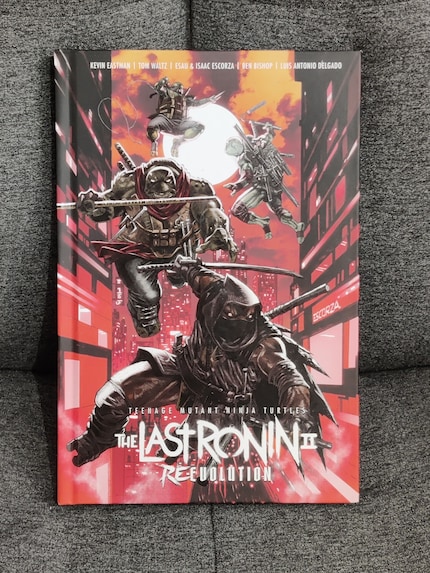
Recap: The Last Ronin is the darkest Turtle story yet
Before we talk about Re-Evolution, I want to address what The Last Ronin actually was and why it made such an impact. First of all, it wasn’t a typical Ninja Turtles story. There was no underground pizza fun. No cowabunga memes, no happy sewer-dwelling rat family.
It was a tragedy.
The comic was published as a five-part miniseries between October 2020 and April 2022. In July 2022, it was released as a complete edition.
Things start off brutal: three of the four Turtles are dead. Splinter is no more. New York has descended into a technocratic military dictatorship ruled by Oroku Hiroto, Shredder’s grandson. And in the midst of this dystopian hellhole, a lone Turtle, Michelangelo, wanders through the night. A warrior carrying his brothers’ weapons. A silent tribute to what once was. The most cheerful, easy-going Turtle of them all is now the last one standing. And he’s angry, broken, out for revenge and racked with guilt.
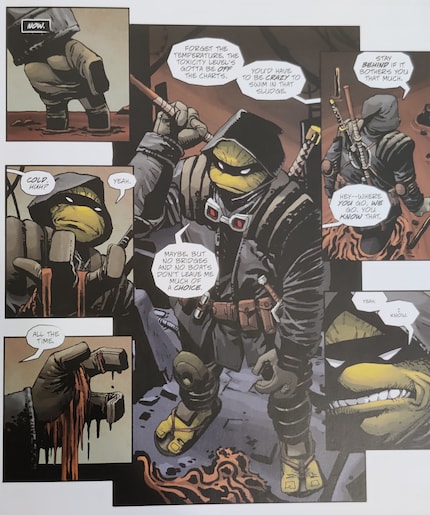
The Last Ronin wasn’t just a homage to old Turtles comics. It drew a line under things. It was a swan song, a gloomy «what if?» and, at the same time, a comic that took risks. Tackling violence, death and trauma, the panels rarely feel as heavy as they did in this comic. But at the same time, the story always contained this quiet sense of hope. The belief that honour and heart are still possible, even in a post-apocalyptic nightmare. And Michelangelo, as lost as he was, became a legend.
At the end of The Last Ronin, the first instalment in the series, Michelangelo dies. His death signalled not just the end of an era, but the beginning of a new one. Just as the story’s drawing to a close, it’s revealed that April O’Neil and her daughter Casey Marie Jones have secretly used Michelangelo’s DNA to create a new generation of genetically modified mutant Turtles.
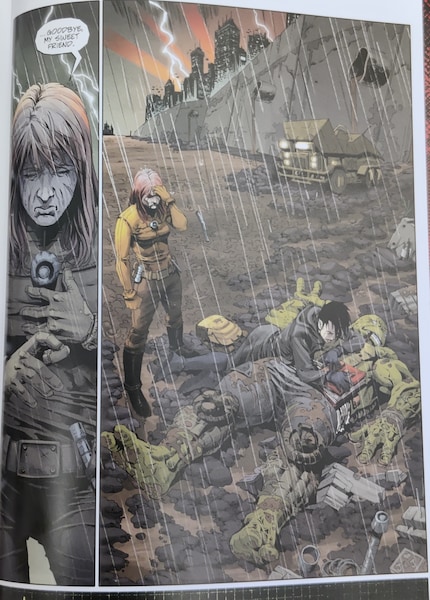
The second chapter, The Lost Years, looks back on Mikey’s final years: his journey into exile, his inner struggles, the hard training he goes through, far from home. In other words, everything that turned him into that broken Ronin in the first place. At the same time, the comic shows us Casey Marie raising the young Turtles. In the present (after Mikey’s death), they’re still immature, angry and uncontrollable. But they’re there. And they’re growing up.
The Lost Years isn’t just a side story. It’s the emotional foundation built between a farewell and a new beginning. It helps us understand Mikey’s character development, all while quietly yet powerfully setting the stage for Re-Evolution’s focal point: the new generation.
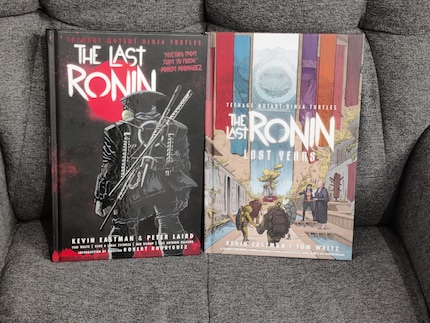


Teenage Mutant Ninja Turtles: The Last Ronin - Lost Years
German, Tom Waltz, Kevin Eastman, 2024
Making sense of Re-Evolution: what happens after the last Ronin?
What’s left after the last Ronin falls? Re-Evolution has an answer to that. A courageous, but also risky answer. You see, this comic doesn’t seamlessly follow on from the end of the original story. Instead, it jumps several years into the future. Into a world which, although still destroyed on the outside, is showing signs of movement on the inside.
New York is still a place of pain, controlled by an authoritarian regime. A regime that rules over the desperate population with brutal surveillance, cybernetically modified soldiers and systematic fear. But the tone has shifted. Instead of a tragic swan song, nervous energy now prevails. One that clearly emerges by way of the plot, images and narrative style. While The Last Ronin was an ending, Re-Evolution is a new beginning. A beginning full of anger, chaos and the clumsy attempt to live up to a legacy none of the new protagonists understand.
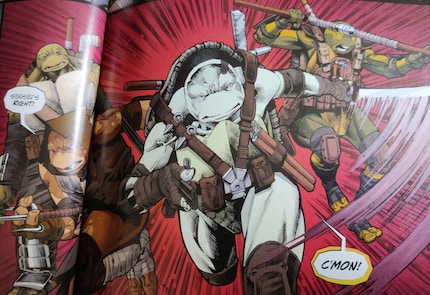
At the centre of it all is a new generation. Instead of lone fighters, we have four young mutants who’ve inherited a destiny they don’t understand. The comic is less interested in revenge or coming to terms with the past, and more interested in identity, self-discovery and the chaos of new beginnings. It’s about failure being a part of growth, and stumbling on your way to finding your own voice. It also deals with the question of whether you’d even want to be a hero in a world that stopped believing in heroes a long time ago.
All of this is accompanied by a noticeable change in tone. The Last Ronin was a calm, almost mythological tragedy, with The Lost Years deepening that stillness. Meanwhile, Re-Evolution strikes a more restless chord. The comic seems peppier and more driven, without getting lost in chaos. The uncertainty of the present replaces the heaviness of the past.
Spotlight on the story and characters: four new voices emerge, echoing the past
And that’s exactly what the emotional core of Re-Evolution is. These new Turtles are no heroes. Not yet. They’re teenagers with weapons and guilty consciences, born into a role they’ve neither asked for nor prepared for. It’s palpable from the very first scene.
Uno’s the loudest in the room, and he knows it. With his greyish, pale-green shell, confident presence and a good dose of arrogance, he’s a born show-off. He loves demonstrating what he can do, even if it’s at the expense of others – especially if it’s his brother Odyn. Uno’s capable, fast and smart, but he’s also difficult. His behaviour causes friction, and it’s clear he won’t simply bow out without a fight when it comes to the question of leadership in future.
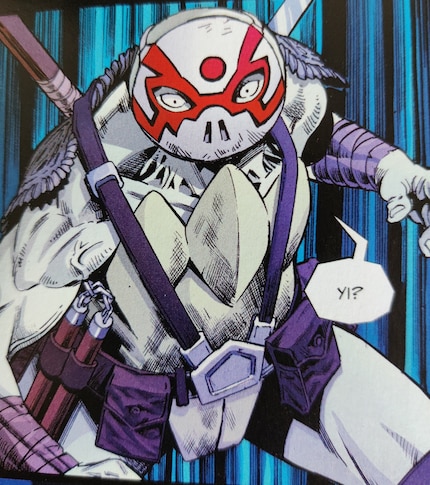
At first glance, Moja seems to be the opposite. Though smaller than Uno, she has a strong build, as well as a distinctive snout and brown skin that gives her a unique look. She, too, has leadership ambitions. She’s just more subtle about it. Moja’s focused, serious and brings a certain down-to-earth attitude to the team. Between her and Uno, there’s both friction and an unspoken question: which of them has what it takes to be the leader?
Odyn is the gentle giant of the group. Although he’s the largest and strongest of the four, he’s soft as pizza dough on the inside. He’s friendly, sensitive, sometimes a little slow and always hungry. Odyn doesn’t like training and is often teased by Uno. However, I feel like there’s more to him than even he thinks. This quickly makes him my favourite of the new Turtles. Maybe it’s his good-natured personality that makes him a kind of moral centre of the group – even if he himself would never see it that way.
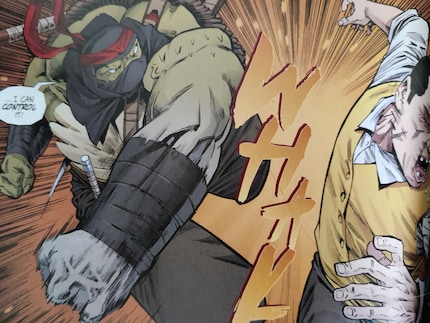
Yi may be the quietest of the four Turtles, but you shouldn’t underestimate her. With her grey-green mottling and natural mask around her eyes, she almost looks like a figure from an ancient myth. Behind the quiet demeanour, however, lies an alert, analytical mind. Yi’s the most intelligent member of the team – a passionate tinkerer, bookworm and technology nerd. While her siblings are training or bickering, she’s repairing equipment, reading through old archives or losing herself in thought.
Without Casey Marie Jones, these young mutants would be lost. As the daughter of April O’Neil and Casey Jones, she carries the legacy of two icons on her shoulders. Not only is she the new Turtles’ mentor, but she’s also the last remaining defender of a city long on the brink of collapse. She seems scarred by these years of resistance, loss and responsibility. Both her monologues and the way she’s drawn make her inner turmoil palpable. Aware she can no longer win this war alone, she creates the next generation. Not as a replacement, but as a ray of hope.
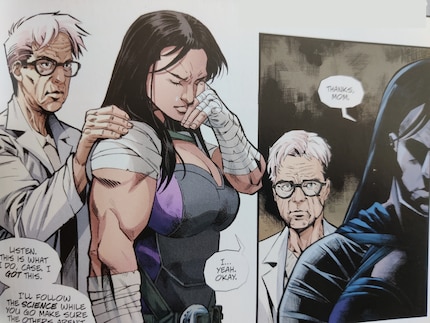
April O’Neil remains more than just a shadow of the past. Although she’s grown older and more cautious, she’s by no means weaker. Working in the background, she serves as a moral compass, an archivist of old knowledge and a silent force in the reconstruction effort. The relationship between mother and daughter is complex, characterised by pride, concern and a deep mutual understanding.
They’re joined by several secondary characters who intensify the comic’s dystopian world image:
- Mayor Palmiotti is a politician under pressure, torn between public responsibility and private interests. His connection to dubious financial backers makes him an ambivalent character.
- Chief Farley and Lieutenant Jiro Watanabe represent a police force that’s lost control of its beat. Their loyalties are unclear, and their role within the power structure is fragile. Watanabe’s also casually involved with Casey Marie Jones.
- Amanda Rose Konnor is a Channel 6 reporter who acts as a media observer and potential voice of the public.
- Professor Zayton Honeycutt, also known as Fugitoid, is one of the most fascinating supporting characters in Re-Evolution. As the cybernetically transferred mind of a brilliant scientist, he brings not only technical know-how but also moral depth to the story. While his role isn’t a central one (yet), his connection to the Turtles’ past as well as his knowledge of technology and mutations make him a potentially crucial character.
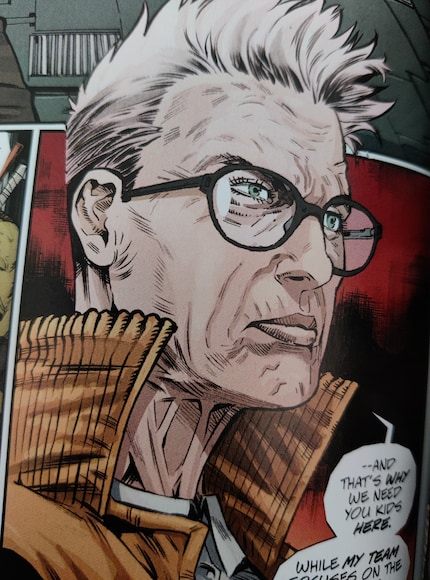
Art style and atmosphere: cybernetic scrap, neon grief and raw energy
Re-Evolution has carved out its own visual style. While The Last Ronin was heavy and almost movie-like, this comic is edgier, sharper and more garish. The world isn’t in ruins anymore. Instead, it’s an asymmetrical cyborg construct boasting spy drones, LEDs in disrepair and concrete bridges with power lines. New York no longer merely looks lost. It looks mutated.
The panels are often overloaded and full of movement, with gaudy colour accents. Sometimes, I almost lose track of what’s going on, but that’s part of the effect. It’s that feeling of being overwhelmed. Disorientation. Like a teenager brandishing a weapon they don’t know how to use.
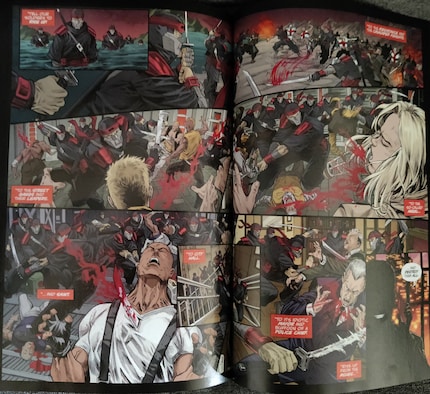
But there are also images of stillness. Moments when time seems to stop. A view of the old Turtle hideout, abandoned and dusty. A monologue on the edge of a roof. Graffiti of a masked Michelangelo. These panels feel like sharp breaths in between two explosions.
Themes and motifs: legacy, anger and the right to a future
Re-Evolution is a comic about struggle. Not just physical struggles, but existential ones too. The struggle for meaning. The right to define what being a hero really is.
Re-Evolution’s central theme is legacy and what it means to have to carry one. The four new Turtles live in the shadow of a legend greater than themselves; they were created to be the next iteration of that legend. But what if they don’t want that? What if this legacy is a burden, not a gift?
This conflict runs through every interaction. Yi in particular is open in saying this several times: they didn’t choose any of this. She says she doesn’t know whether she wants to fight or whether she only does so because others expect her to. Re-Evolution addresses the question of whether passing on trauma is also a form of violence surprisingly openly. Casey Marie trains the Turtles with the best of intentions, but sometimes she can’t let go of her own anger.
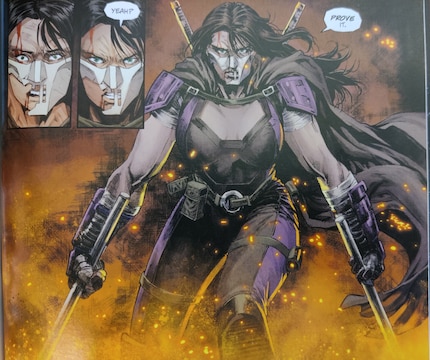
It’s also about anger as a driving force – and its darker side. Moja embodies this in an almost physical way. She wants to fight, strike, rebel, but doesn’t know exactly what against. The regime is overly powerful, the city indifferent. The enemy is diffuse, which often makes the violence random. The question is: where does blind rebellion end and real change begin?
Classic coming-of-age themes crop up alongside this, without making the comic sound like a young adult novel. These include self-discovery, loyalty, betrayal, shame and longing. The four Turtles are young, and I notice that straight away. They don’t launch into big monologues like Splinter once did. They yell, hesitate and make mistakes. And that’s exactly what’s so touching.
Another underestimated but powerful theme of the comic is belonging. These Turtles weren’t created by accident, but deliberately. And that raises questions. Do they even have the capacity to be free? Or are they products of a failed generation desperately trying to preserve what once was? The relationship between Casey Marie and April, between the new and old worlds, illustrates this quietly but effectively.
April seems like someone who knows history shouldn’t simply repeat itself without question. Professor Honeycutt also slots into this moral grey area. His character serves as a kind of moral compass, especially for April. He critiques her decisions, asks ethical questions about the creation of the new generation and reminds her that good intentions don’t automatically create good results.
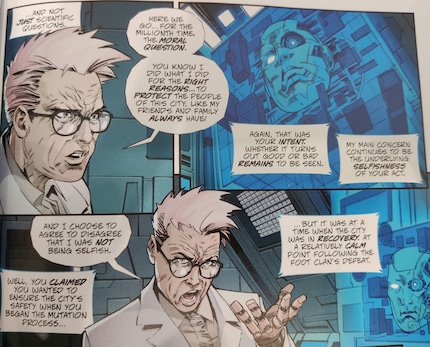
The theme of technological control through drones, cyborgs and digital surveillance is interesting too, but it’s never shoved under the readers’ noses. It stays as a backdrop, albeit a threatening one. A constant flickering in the background, reminding us that this isn’t just about personal struggles. This is about an entire system in which freedom no longer exists.
Criticism + praise: between new beginnings and legacy
The switch in perspective works well. Instead of feeling like a reboot, this jump to the next generation feels like a necessary step. The dynamic between the four Turtles works too. Not because it’s smooth, but because it’s not. I can feel the tension, the immaturity, the disagreement. There’s no pretence of harmony. The characters argue, jostle and brim with insecurities. This brings the comic to life and makes the characters believable.
The comic also sets the right emotional tenor. When Yi’s feeling desperate, I notice it. When Uno makes a silly comment while the world’s burning behind him, it hurts because I realise it’s a defence mechanism. These characters don’t feel as if they’ve been written. They feel real. Considering we’re talking about a franchise that’s existed for decades, that’s not a given.
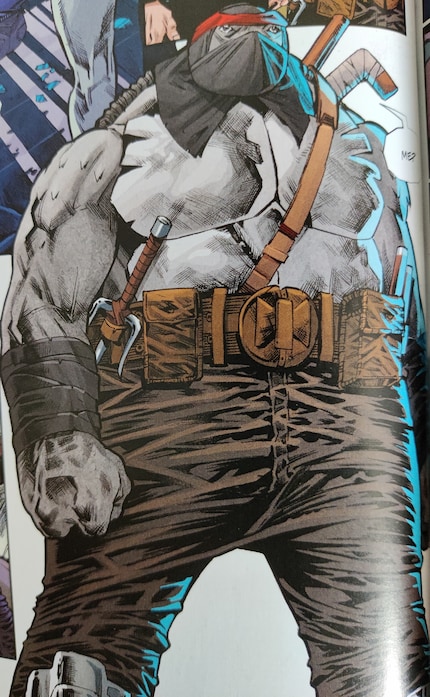
The worldbuilding deserves praise too. This new, run-down New York isn’t just a dystopian copy of other post-apocalyptic cities – it has a life of its own. Surveillance, resistance, technical mutation and social decay all seems credible in their abstraction. The threat is real, but never thrust under our noses. It’s a society that pretends to have a moral compass it lost a long time ago.
One area that the comic’s slightly shaky on is pacing. Some scenes almost rush past you. The structure’s strong, the character conflicts are well executed, but as soon as action takes centre stage, everything seems a little overloaded. There’s no room to breathe. During large confrontations especially, I found myself asking, «Wait, was that the climax or just another step forward?»
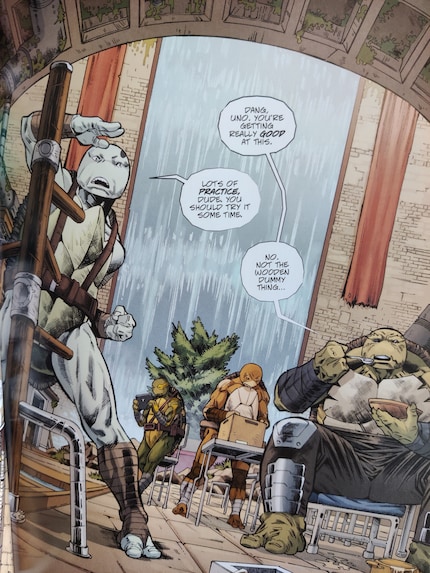
But all of this – the little stumbles, the hurriedness, the occasional chaos – feels strangely fitting. Because Re-Evolution is exactly that: a work in progress. Like its characters, the comic itself is yet to settle on a tone. And that’s exactly what makes it so exciting. It’s brave enough not to aim for smoothness. With a franchise of this size, that’s a compliment.
I’m really looking forward to the next instalment – especially after all the big twists, which I went out of my way not to mention here.
In a nutshell
Young, angry, rough around the edges, but full of heart
The Last Ronin II – Re-Evolution isn’t just some nostalgic rehash. Instead, it’s a bold change of direction. The comic has ventured out of the shadows of the past, throwing itself behind a new generation: a band of insecure, quarrelling, doubt-filled mutants still fighting for their place in the world. As a result, many powerful moments arise.
What sets this volume apart from others is its sense of emotional disquiet. It all feels a little raw, a little rough around the edges. But that’s exactly where its appeal lies. The worldbuilding is impressive, with living, breathing characters. On the other hand, the tone is erratic and the pacing isn’t always smooth. In action scenes in particular, the story feels hurried.
However, aside from some minor weaknesses and a bumpy structure, Re-Evolution proves that the Turtles franchise is far from over.
Pro
- Bold change of tone with youthful vigour
- Emotionally believable new Turtles
- Powerful visual language and atmospheric worldbuilding
- Topical themes such as identity, legacy and belonging
Contra
- Narrative structure seems fragmented in places
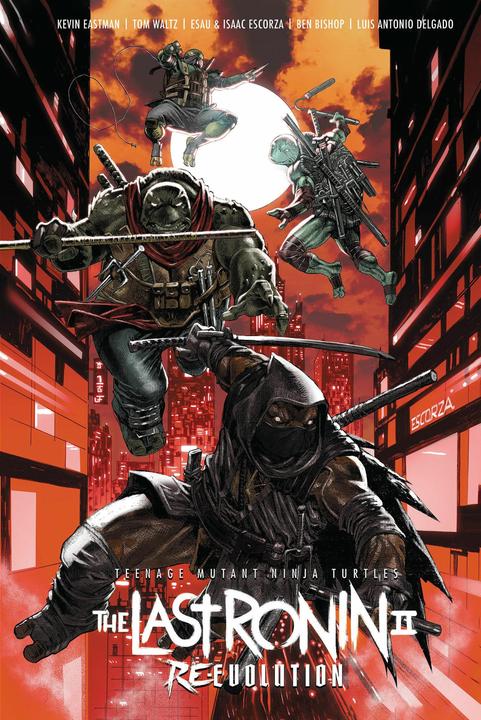
Teenage Mutant Ninja Turtles: The Last Ronin II--Re-Evolution
English, Tom Waltz, Kevin Eastman, Escorza Brothers, Ben Bishop, 2025
My interests are varied, I just like to enjoy life. Always on the lookout for news about darts, gaming, films and series.
Which films, shows, books, games or board games are genuinely great? Recommendations from our personal experience.
Show all